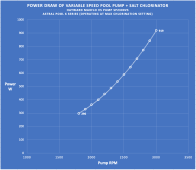Just getting started in the solar world. I've got a long electronics repair & computer science background plus many years of DIY plumbing and electrical work behind me so I'm not completely clueless (I hope).
We're buying a house in an area served by Duke energy, and that means higher rates than we're used to. Our current pool system is a single-speed 230v power hog, but at least it has solar heating panels on the roof. Pool is roughly 15 x 30, pretty standard.
I have been soaking up info about DC powered pumps running off of solar. It seems to me that the risk comes in a scenario where it's cloudy for consecutive days and the solar panels just can't produce enough to keep the pool clean. That means either a battery bank, a hybrid system or just plumbing in a DC pump in parallel with the existing pump to manually select when the sun is out.
Trying to spend as little as possible (of course). I came across a thread where the solution was to install a grid-assisted inverter:
- Do you run into permitting issues since this inverter is connected to the grid? Or is this incapable of feeding back to the grid such that an AC service disconnect box is all that you need? Growatt manual does not address this. I know that grid-tie inverters used for net metering are a whole different ball game.
- If the power needed to run the pump is say, 1800w, and the solar panels are producing only 1000w, will the grid-assist feature pull the other 800w from the grid? Or is it an either PV or grid equation?
If I go the straight DC pump & solar panel route:
- Are the DC pumps powerful enough that I can just forgo the AC pump & inverter complexity all together? My sense is that they are not...
- Since most of these pumps run at higher voltage (72v or 90v) is there an MPPT or DC-DC converter that would pull from a lower voltage battery bank and provide the needed voltage? My thinking is that the cost of building a 72v battery bank is way more than a 24v bank.
- A 'standard' MPPT has output voltages of 12/24/48v. Is there a reliable / quality solar pump controller that can be set to the pump voltage needed? Not looking to buy a chinese knock-off headache box...
TIA for any insights.
We're buying a house in an area served by Duke energy, and that means higher rates than we're used to. Our current pool system is a single-speed 230v power hog, but at least it has solar heating panels on the roof. Pool is roughly 15 x 30, pretty standard.
I have been soaking up info about DC powered pumps running off of solar. It seems to me that the risk comes in a scenario where it's cloudy for consecutive days and the solar panels just can't produce enough to keep the pool clean. That means either a battery bank, a hybrid system or just plumbing in a DC pump in parallel with the existing pump to manually select when the sun is out.
Trying to spend as little as possible (of course). I came across a thread where the solution was to install a grid-assisted inverter:
Growatt 2.2kW 3HP Solar Pump Inverter l Water Pump Inverter | Grid-Assisted | SPI 2200TL2-HV
Several questions about adding this to my system:- Do you run into permitting issues since this inverter is connected to the grid? Or is this incapable of feeding back to the grid such that an AC service disconnect box is all that you need? Growatt manual does not address this. I know that grid-tie inverters used for net metering are a whole different ball game.
- If the power needed to run the pump is say, 1800w, and the solar panels are producing only 1000w, will the grid-assist feature pull the other 800w from the grid? Or is it an either PV or grid equation?
If I go the straight DC pump & solar panel route:
- Are the DC pumps powerful enough that I can just forgo the AC pump & inverter complexity all together? My sense is that they are not...
- Since most of these pumps run at higher voltage (72v or 90v) is there an MPPT or DC-DC converter that would pull from a lower voltage battery bank and provide the needed voltage? My thinking is that the cost of building a 72v battery bank is way more than a 24v bank.
- A 'standard' MPPT has output voltages of 12/24/48v. Is there a reliable / quality solar pump controller that can be set to the pump voltage needed? Not looking to buy a chinese knock-off headache box...
TIA for any insights.




